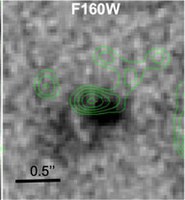The Most Distant Galaxy
Laporte et al. report on the detailed analysis of a gravitationally lensed Y-band dropout – designated A2744_YD4 – selected from deep Hubble Space Telescope (HST) imaging in the Frontier Field cluster Abell 2744. Band 7 observations with ALMA indicate the proximate detection of a significant 1 mm continuum flux suggesting the presence of dust for a star-forming galaxy with a photometric redshift of z = 8.38. Deep X-SHOOTER spectra confirms the high-redshift identity of A2744_YD4 via the detection of Lyα emission at a redshift z = 8.38. The association with the ALMA detection is confirmed by the presence of [O III] 88 μm emission at the same redshift. Although both emission features are only significant at the 4σ level, the authors argue their joint detection and the positional coincidence with a high-redshift dropout in the HST images confirms the physical association. Analysis of the available photometric data and the modest gravitational magnification (μ ~ 2) indicates A2744_YD4 has a stellar mass of ∼2 × 109 M⊙, a star formation rate of ∼20 M⊙ per year and a dust mass of ∼6 × 106 M⊙. These observations imply that the interstellar medium in galaxies can be substantially enriched with metals and dust when the Universe was only ~ 600 million years old.
Image: ALMA image contours superposed on a HST visible (F160W) image.
Publication: N. Laporte (University College London, Pontificia Universidad Católica de Chile, Millennium Institute of Astrophysics) et al., Dust in the Reionization Era: ALMA Observations of a z = 8.38 Gravitationally Lensed Galaxy, 2017, Astrophysical Journal Letters, 837, L21.





Connect with NRAO